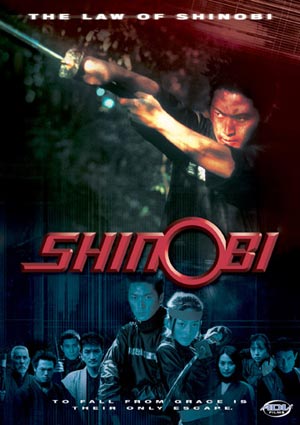| |
|
review | notes | availability | |

Notes:
• Followed by a sequel, Shinobi: Runaway.
• The English audio dubbing on ADV's "literal
translation version" was conducted without
consideration for matching the onscreen lip
movements. Also, the actors improvised at times,
most infamously during a rape scene which they
basically play for laughs.
• The
end credit sequence includes outtakes, rehearsal
footage, and stunt work.
Availability:
DVD (USA)
Region 1 NTSC
ADV Films
Widescreen
Japanese and English Dubbed Language Tracks
Dolby Digital 5.1
Removable English Subtitles
Literal English Translation Version, Trailers
|
|
| |
Review by
Calvin
McMillin: |
Shot on digital
video, Kenji Tanigaki's Shinobi: Law of Shinobi
follows the exploits of Kagerou (Kenji Matsuda),
the top pupil in a secret ninja clan. Being
the number one student would be quite the accomplishment
if it weren't for the fact that Kagerou was
born into the lower Genin caste of ninjas, as
opposed to the high-level Jonin class. Briefly,
the ninja hierarchy works like this: the Genin
are the foot soldiers while the Jonin are the
master strategists. Thus, the Genin's lives
are pretty much marked for death. Disturbed
by the futility of it all, Kagerou seeks to
overcome his station in life and finds an ally
in Aoi (Maju Ozawa), a fellow Genin who is treated
poorly by most of the other shinobi simply because
she's a woman. But Kagerou has a friendly history
with Aoi and trusts her implicitly, which makes
her the perfect sidekick. And when a war erupts
between rival factions within the clan, this
somewhat dynamic duo seizes the opportunity
to change their fates. One problem: a lot of
people want them dead. Cue the slicing and dicing.
Shinobi: Law
of Shinobi isn't exactly high art. A lot
of times it feels like a cheesy B-movie, which
is understandable considering its direct-to-video
status. A big budget isn't necessary to make
a quality film, but it doesn't hurt in helping
amp the believability meter. The lack of funds
is evident in the setting; most of the film's
scant running time is spent in the forest with
little attempt to approximate any historical
time period. Also, the wardrobe doesn't seem
even remotely accurate. For the majority of
the picture, Kagerou wears the ninja equivalent
of an Adidas track suit, rather than something
more in tune with our expectations of "Shinobi
wear." Director Tanigaki was said to have
collaborated with Ryuhei Kitamura on Versus
and Donnie Yen on the Princess Blade.
Knowing that, most people are going to come
into the film looking for some solid martial
arts action. And at times, Shinobi does
provide that, but for the most part, it's so
ineptly shot that it's hard to make sense of
the action.
To be perfectly
honest though, certain aspects of the film do
elevate the material above pure B-movie camp.
Kenji Matsuda almost seems to be acting in another,
better movie than some of his castmates. Matsuda's
ability to infuse his character with a supreme
sense of confidence and his knack for taking
everything fairly seriously make the character
a standout. His swordsman means business, a
trait that intensifies any swordplay sequence
his character is involved with. Maju Ozawa does
well as the feisty, rebellious Aoi, and there's
good chemistry between the two leads. Their
constant back-and-forth bickering is pretty
entertaining to watch, especially since the
actors are able to convey a genuine affection
for each other. In an interesting move, the
filmmakers actually try to infuse a sense of
dramatic importance into the story, by allowing
the characters to muse on the futility of the
ninja lifestyle. Although the grave ponderings
might seem incongruent with the B-movie feel,
the attempt to give the story more depth saves
it from being a completely mindless (and thus,
pointless) crapfest. Are those positives enough
to recommend the film? Let me put it this way:
if you really like ninjas, then this particular
example of Japanese V-Cinema will make for an
entertaining distraction. But if ninjas don't
really do it for you, then neither will Shinobi.
(Calvin McMillin, 2005)
|
|